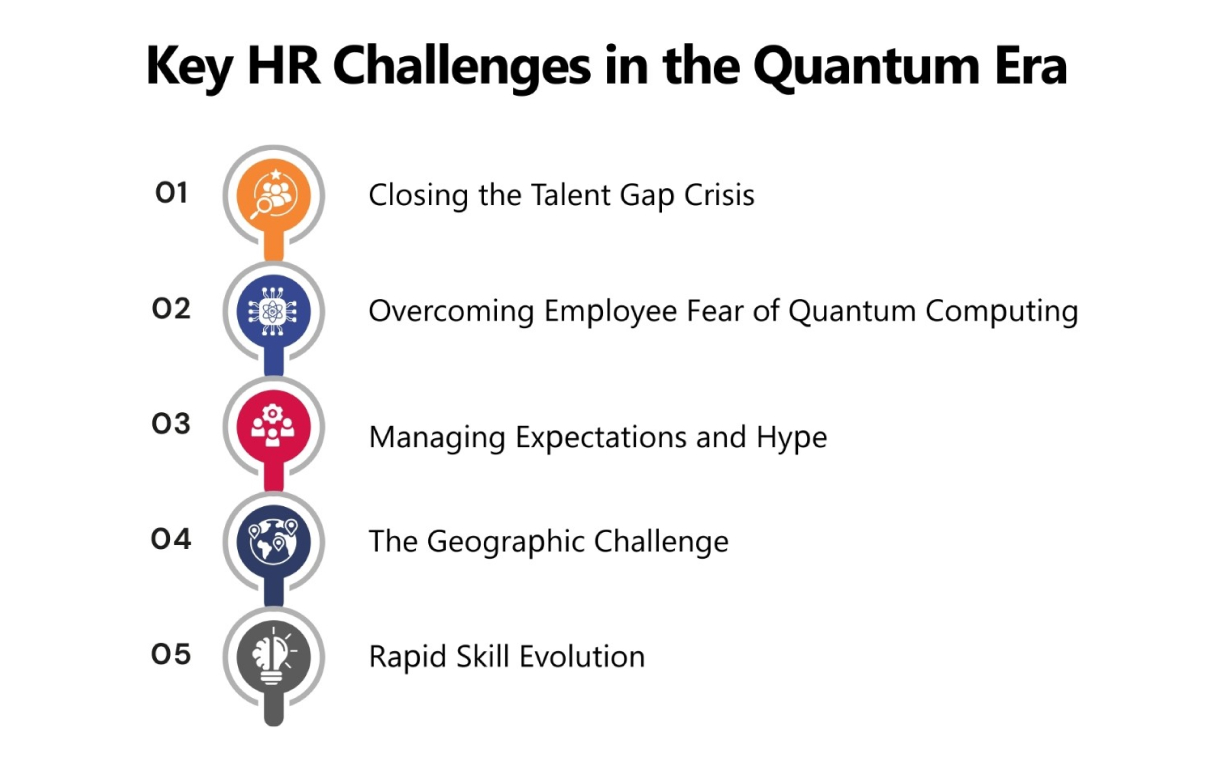
The workplace is about to experience its most dramatic transformation since the digital revolution. As quantum computing moves from research labs to real-world applications, Human Resource Management faces an unprecedented challenge: preparing the workforce for a technology that most people find mysterious and intimidating.
The quantum technology market is projected to experience dramatic growth, with forecasts suggesting it could reach a valuation of $173 billion by 2040. This represents a significant potential market opportunity over the next several decades. Public investment in quantum technology (QT) has reached approximately $42 billion globally, with several nations making substantial financial commitments. Three countries have emerged as leading investors: Germany, the UK, and South Korea, who are spearheading major new funding initiatives in this field.
This isn't just another tech trend. Quantum computing represents a fundamental shift in how we process information and solve problems. For HR professionals, this means rethinking everything from talent acquisition to training programs, from organizational structure to performance management.
Let's start with a simple truth: quantum computing is no longer a distant dream. Microsoft's recent unveiling of its Majorana chip and the launch of its Quantum Ready program signal that we're entering the era of practical quantum applications. McKinsey predicts the quantum market could reach $100 billion within a decade, with potential to generate $1-2 trillion in value across industries by 2035.
But what exactly is quantum computing? Unlike traditional computers that process information as either 0s or 1s, quantum computers use quantum bits (qubits) that can exist in multiple states simultaneously. This allows them to solve complex problems exponentially faster than classical computers. Problems that would take today's supercomputers years to solve could be completed by quantum computers in minutes.
For HR professionals, understanding this technology isn't about becoming quantum physicists. It's about recognizing how this paradigm shift will transform every aspect of workforce management and preparing accordingly.
The quantum industry is experiencing explosive growth. Recent data shows that 39% of quantum companies now employ more than 100 people, up from just 9% the previous year. Governments worldwide announced $1.8 billion in funding for quantum technology initiatives in 2024 alone.
However, this rapid growth has created a significant challenge: talent scarcity. Industry executives describe the talent shortage as "amazing" and "huge." The issue isn't just finding quantum physicists—it's particularly acute for engineers who understand both traditional systems and quantum concepts.
While early quantum companies relied heavily on PhD physicists, the industry now needs a broader range of professionals:
Let’s explore the key HR challenges in the quantum era:

The quantum industry faces a unique talent shortage that goes beyond simple numbers. Companies report several specific challenges:
Engineers with Quantum Awareness: The most critical shortage is engineers who understand both classical and quantum systems. These professionals don't need PhD-level quantum physics knowledge, but they do need enough understanding to work effectively with quantum technologies.
Bridge Professionals: There's a growing need for professionals who can translate between quantum capabilities and business value. These "quantum analytics translators" understand both the technical possibilities and business applications.
Systems Integration Experts: As quantum technologies move from labs to production, companies desperately need professionals who can integrate quantum systems into existing infrastructure. This requires a unique combination of quantum knowledge and traditional engineering skills.
Quantum-Literate Business Professionals: Companies need business professionals who can identify quantum opportunities, develop business cases, and manage quantum projects effectively.
One of HR's biggest challenges is overcoming the intimidation factor associated with quantum computing. Many professionals, especially those with years of experience in traditional technologies, find quantum concepts "spooky" and incomprehensible.
This fear creates several problems:
Media coverage of quantum computing often swings between extremes, creating unrealistic expectations. HR must manage the "hype problem" by helping employees and candidates understand:
Quantum talent is globally distributed, creating unique challenges for HR:
Small companies face particular challenges, as they often prefer hiring locally for stability but find the local talent pool insufficient.
The quantum field evolves rapidly, creating challenges for workforce planning:
As quantum computing reshapes industries, building a quantum-ready workforce strategy is essential for staying competitive. This phased approach outlines a practical roadmap to prepare your organization, integrating HR, technology, and business goals. Below are the steps for each phase to develop a skilled quantum computing workforce.
1. Conduct a Quantum Readiness Assessment
Start by understanding your organization's current state:
2. Establish a Quantum Task Force
Create a cross-functional team to guide your quantum journey:
3. Launch an Awareness Campaign
Begin building quantum awareness across your organization:
1. Implement Tiered Training Programs
Develop training programs tailored to different needs.
Level 1 - Quantum Awareness (All Employees)
Level 2 - Quantum Literacy (Selected Roles)
Level 3 - Quantum Proficiency (Technical Teams)
Level 4 - Quantum Expertise (Quantum Team)
2. Create Learning Pathways
Design clear progression routes for different roles.
For Engineers:
For Business Professionals:
For Executives:
3. Foster Internal Knowledge Sharing
Create mechanisms for continuous learning.
1. Recruit Strategic Talent
Develop a comprehensive quantum recruitment strategy.
Target Profiles:
Recruitment Strategies:
2. Build Quantum Partnerships
Establish strategic relationships to accelerate your quantum journey.
3. Measure and Iterate
Develop metrics to track your quantum workforce development.
As the quantum computing workforce evolves, tailored training approaches are crucial to equip different groups with the right skills. This section outlines specific strategies for engineers, business professionals, and HR professionals to thrive in the quantum era, aligning with their unique roles and needs.
Engineers form the backbone of the quantum workforce, but they don't all need to become quantum physicists. The key is providing appropriate levels of quantum knowledge:
Business professionals need different quantum skills than technical staff:
HR professionals themselves need quantum knowledge to effectively manage the quantum workforce transformation:
Different industries will experience quantum's impact at different times and in different ways. As quantum computing evolves, its influence varies based on each sector’s needs and readiness. Below, we explore how key industries are approaching this transformation:
The finance sector is an early adopter of quantum computing. It uses quantum to optimize risk models, enhance fraud detection, and improve portfolio management. The ability to process vast datasets quickly gives banks a competitive edge. Goldman Sachs has explored quantum for derivative pricing. Their team developed algorithms that outperform classical methods, showing promise for faster, more accurate financial simulations.
Quantum computing accelerates drug discovery by simulating molecular interactions. This reduces R&D costs and speeds up time to market. Healthcare benefits from improved diagnostics through quantum sensing. Pfizer is using quantum simulations to model complex proteins. Their progress shows quantum’s potential to transform medical research.
The energy sector leverages quantum to optimize grids and develop new materials. This supports renewable energy integration and sustainable innovations like advanced batteries. Volkswagen partnered with D-Wave to optimize traffic flow in Beijing.
Quantum computing poses risks by breaking current encryption but also offers solutions like quantum key distribution (QKD). Preparing for a post-quantum world is critical. Microsoft is developing lattice-based cryptography to resist quantum attacks. Their work ensures secure communication channels, protecting sensitive data as quantum threats grow.
As organizations navigate the quantum computing landscape, overcoming common obstacles is key to building a successful quantum-ready workforce strategy. This section outlines practical approaches for HR to address fear, manage hype, and adapt to rapid changes in the quantum era.
Many employees find quantum computing intimidating. HR can help by:
Unrealistic expectations can derail quantum initiatives. HR should:
The quantum field evolves quickly. HR must build adaptability:
Developing a robust quantum computing workforce requires strategic planning and execution. This section highlights best practices for HR to foster a quantum-ready workforce strategy.
Don't wait for quantum to mature fully. Begin with:
Build a strong foundation:
Different people learn differently:
Identify and develop quantum advocates:
Don't go it alone:
Track your quantum workforce development:
Organizations that wait for quantum technology to mature before preparing their workforce will find themselves at a severe competitive disadvantage. The time to act is now. Human Resource Management stands at the forefront of this transformation. HR professionals must lead the charge in building quantum-ready organizations by:
The quantum computing workforce challenge is significant but not insurmountable. By starting now with a thoughtful, comprehensive approach to workforce development, organizations can position themselves to thrive in the quantum era.
The choice is clear: organizations can either lead the quantum transformation or be disrupted by it. For HR professionals & talent management professionals, this represents both an enormous challenge and an unprecedented opportunity to shape the future of work.
As we stand at the threshold of the quantum age, one thing is certain: the organizations that succeed will be those that recognize the transformative power of quantum computing and act decisively to prepare their workforce for this new reality. The quantum future belongs to those who prepare for it today.

CredBadge™ is a proprietary, secure, digital badging platform that provides for seamless authentication and verification of credentials across digital media worldwide.
CredBadge™ powered credentials ensure that professionals can showcase and verify their qualifications and credentials across all digital platforms, and at any time, across the planet.

Please enter the License Number/Unique Credential Code of the certificant. Results will be displayed if the person holds an active credential from TMI.